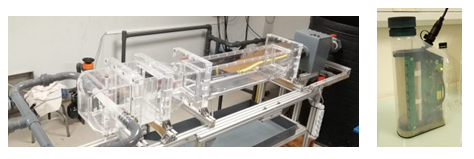
WP 1. Microplastic vertical dynamics under hyperturbid conditions
This work package aims to describe the vertical dynamics of microplastics, in particular their settling dynamics in hyperturbid environments and their erodability in cohesive sediment beds. For these purposes, laboratory experiments will be carried out using an optical settling column and a hydraulic transparent flume.

WP 2. Microplastic and hydrodynamics monitoring
The main goal of WP2 is to evaluate the spatio-temporal variability of microplastics and key physical parameters (e.g. current velocities, salinity, temperature) at the estuary scale from in-situ observations. Special attention will be paid to the observation of key trapping processes such as estuarine fronts and Estuarine Microplastics Maxima.

WP 3. Process-based numerical modelling for the transport of microplastics
In WP3, the TrackMPD numerical model for the transport of microplastics will be improved (e.g. by including specific microplastic behaviours in hyperturbid environments), coupled with the TELEMAC hydrodynamic model, and implemented in the macrotidal Gironde estuary. Numerical simulations will allow for analyzing meteorological and oceanographic conditions that did not occur during the observation period (WP2.1), assessing retrospective or prospective conditions, and testing hypotheses on microplastic dynamics.

WP 4. Microplastic transport and drivers
In WP4, the three first WPs and existing datasets will be combined to (1) advance knowledge of microplastic transport at the estuary scale under the influence of changing environmental forcings; (2) identify the relative contributions of the different physical and biochemical processes on microplastic dynamics; (3) understand the role of estuaries as sources and sinks of microplastics.
WP 5. Management and knowledge transfer
WP 5 covers the project coordination, its financial and administrative management, and the dissemination of scientific knowledge to the scientific community, stakeholders and the general public.
